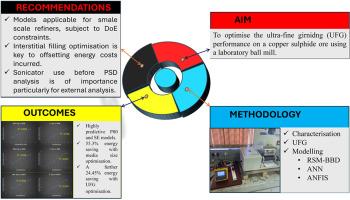超细硫化铜磨削的建模和优化:一种混合统计和机器学习方法
IF 4.3
2区 材料科学
Q2 ENGINEERING, CHEMICAL
引用次数: 0
摘要
随着对贱金属的需求不断增加,在过去几十年中,向选矿低品位矿石和二次资源的转变一直在稳步增加。采用超细磨矿机械活化低品位硫化铜矿石颗粒表面,优化其选矿工艺。作为一个能量密集的过程,本研究试图简化铣削介质粒度影响操作条件的方式,以微调铣削效率(P80)及其比能耗(SE)。运行工况的内在相互作用行为;通过响应面法、人工神经网络(ANN)和人工神经模糊推理系统(ANFIS)方法的混合建模技术,揭示了磨矿速度、磨矿时间和磨矿介质填充比等参数。通过该方法发现,本研究中依赖的基线工艺参数为介质填充率(%)。在较低介质填充比下,铣削速度对工艺性能的影响基本不大,但随着介质填充比的增加,铣削速度对工艺性能的影响呈反比。对于磨矿时间,磨矿时间与介质填充比成正比关系,其比例常数可根据设定的条件进行微调。通过优化研究,确定了介质填充比、磨矿时间和磨矿速度分别为60%、1 h和106转/分的最佳条件。在传统的10 μm的Activox工艺的基础上,将磨削范围优化到P80为20 μm,实现了24.45%的SE节约。使用不同硫化物矿石对混合模型进行验证,得出了ANFIS模型对P80预测的优越性,而ANN模型对SE预测的优越性。这项研究解决了特别是小型采矿者的需要,即有效地进行机械活化,而不必花费新的碾磨设备。本文章由计算机程序翻译,如有差异,请以英文原文为准。

Modelling and optimization of ultra-fine copper sulphide grinding: A hybrid statistical and machine learning approach
As the demand for base metals continues to increase, the shift to beneficiating low-grade ores and secondary sources has been steadily increasing over the past decades. This study aimed at optimizing the beneficiation of low-grade copper sulphide ores by applying ultra-fine grinding to mechanically activate its mineral grain surfaces. As an energy intense process, this study sought to streamline the manner in which the milling media particle size impacts the operating conditions, for fine-tuning the process milling efficiency (P80), and its specific energy consumption (SE). The intrinsic interaction behaviors of the operating conditions; milling speed, milling time and grinding media filling ratio, were uncovered through a hybrid modelling technique involving the response surface methodology, artificial neural network (ANN) and artificial-neuro-fuzzy-inference-system (ANFIS) approaches. Through this methodology, it was revealed that the baseline process parameter of dependence, to the rest in this study was the media filling ratio (%). At lower media filling ratios, it was noted that basically the milling speed did not bear much influence on the process performance, however, an inverse impact to the process performance was observed with increasing media filling ratio. For milling time, a direct proportionality was observed between it and media filling ratio, and its proportionality constant could be finely tuned as per set conditions. Optimization study led to adoption of the optimum conditions of media filling ratio, milling time and milling speed of 60 %, 1 h and 106 revolutions per minute (RPM) respectively. Upon optimizing the grinding extent to P80 of 20 μm, a 24.45 % SE conservation was realized, basing on the traditional 10 μm of the Activox process. Validation of the hybrid models using a different sulphide ore drew the superiority of the ANFIS model for P80 predictions, and that of ANN for SE predictions. This study addressed the need, particularly of small-scale miners, to effectively conduct mechanical activation without necessarily incurring expenditure on new milling equipment.
求助全文
通过发布文献求助,成功后即可免费获取论文全文。
去求助
来源期刊

Particuology
工程技术-材料科学:综合
CiteScore
6.70
自引率
2.90%
发文量
1730
审稿时长
32 days
期刊介绍:
The word ‘particuology’ was coined to parallel the discipline for the science and technology of particles.
Particuology is an interdisciplinary journal that publishes frontier research articles and critical reviews on the discovery, formulation and engineering of particulate materials, processes and systems. It especially welcomes contributions utilising advanced theoretical, modelling and measurement methods to enable the discovery and creation of new particulate materials, and the manufacturing of functional particulate-based products, such as sensors.
Papers are handled by Thematic Editors who oversee contributions from specific subject fields. These fields are classified into: Particle Synthesis and Modification; Particle Characterization and Measurement; Granular Systems and Bulk Solids Technology; Fluidization and Particle-Fluid Systems; Aerosols; and Applications of Particle Technology.
Key topics concerning the creation and processing of particulates include:
-Modelling and simulation of particle formation, collective behaviour of particles and systems for particle production over a broad spectrum of length scales
-Mining of experimental data for particle synthesis and surface properties to facilitate the creation of new materials and processes
-Particle design and preparation including controlled response and sensing functionalities in formation, delivery systems and biological systems, etc.
-Experimental and computational methods for visualization and analysis of particulate system.
These topics are broadly relevant to the production of materials, pharmaceuticals and food, and to the conversion of energy resources to fuels and protection of the environment.
 求助内容:
求助内容: 应助结果提醒方式:
应助结果提醒方式:


